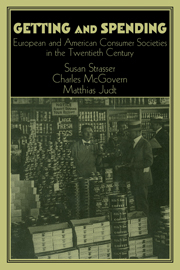Book contents
- Frontmatter
- Introduction
- Part One Politics, Markets, and the State
- Part Two Everyday Life
- 9 World War I and the Creation of Desire for Automobiles in Germany
- 10 Gender, Generation, and Consumption in the United States: Working-Class Families in the Interwar Period
- 11 Comparing Apples and Oranges: Housewives and the Politics of Consumption in Interwar Germany
- 12 “The Convenience Is Out of This World”: The Garbage Disposer and American Consumer Culture
- 13 Consumer Culture in the GDR, or How the Struggle for Antimodernity Was Lost on the Battleground of Consumer Culture
- 14 Changes in Consumption as Social Practice in West Germany During the 1950s
- 15 Reshaping Shopping Environments: The Competition Between the City of Boston and Its Suburbs
- 16 Toys, Socialization, and the Commodification of Play
- 17 The “Syndrome of the 1950s” in Switzerland: Cheap Energy, Mass Consumption, and the Environment
- 18 Reflecting on Ethnic Imagery in the Landscape of Commerce, 1945-1975
- Part Three History and Theory
- Index
9 - World War I and the Creation of Desire for Automobiles in Germany
Published online by Cambridge University Press: 05 January 2013
- Frontmatter
- Introduction
- Part One Politics, Markets, and the State
- Part Two Everyday Life
- 9 World War I and the Creation of Desire for Automobiles in Germany
- 10 Gender, Generation, and Consumption in the United States: Working-Class Families in the Interwar Period
- 11 Comparing Apples and Oranges: Housewives and the Politics of Consumption in Interwar Germany
- 12 “The Convenience Is Out of This World”: The Garbage Disposer and American Consumer Culture
- 13 Consumer Culture in the GDR, or How the Struggle for Antimodernity Was Lost on the Battleground of Consumer Culture
- 14 Changes in Consumption as Social Practice in West Germany During the 1950s
- 15 Reshaping Shopping Environments: The Competition Between the City of Boston and Its Suburbs
- 16 Toys, Socialization, and the Commodification of Play
- 17 The “Syndrome of the 1950s” in Switzerland: Cheap Energy, Mass Consumption, and the Environment
- 18 Reflecting on Ethnic Imagery in the Landscape of Commerce, 1945-1975
- Part Three History and Theory
- Index
Summary
War is the greatest of all agents of change. It speeds up all processes, wipes out minor distinctions, brings realities to the surface.
George Orwell, The Lion and the Unicornthe 1920s: desire for automobiles in adverse conditions
Following World War I, several factors adversely affected the popularization of car ownership in Germany, which lagged behind that of other Western countries. In the mid-1920s, there was one car for every 250 Germans. In France and Britain, in contrast, the figure was half of that. The reason for Germany's lower rate of car ownership was primarily economic. Quite unlike in the United States, the cost of purchasing and operating automobiles in Germany was simply far too expensive. The portion of the population able to afford personal motorized transportation was comparatively small, increasing significantly, if only gradually, in the second half of the decade. The inflation crisis of 1922-3, reparations, and the precarious situation of the German economy were among the factors that negatively influenced car ownership. The disposable income of most families was not high enough to operate even a modestly priced motor vehicle.
- Type
- Chapter
- Information
- Getting and SpendingEuropean and American Consumer Societies in the Twentieth Century, pp. 195 - 222Publisher: Cambridge University PressPrint publication year: 1998
- 3
- Cited by



